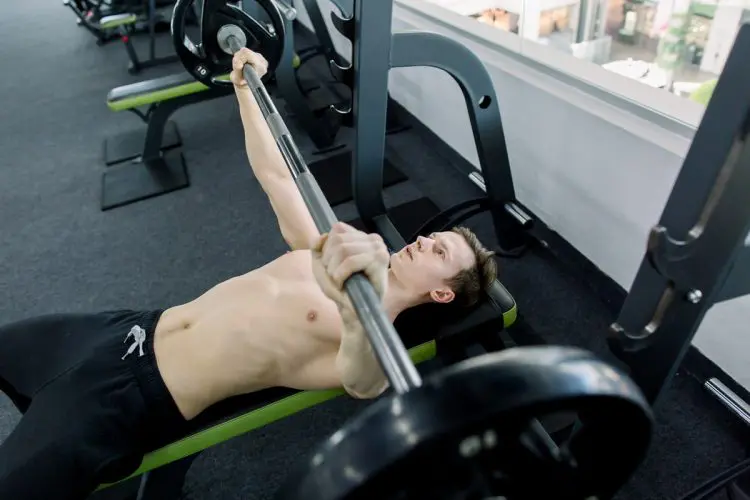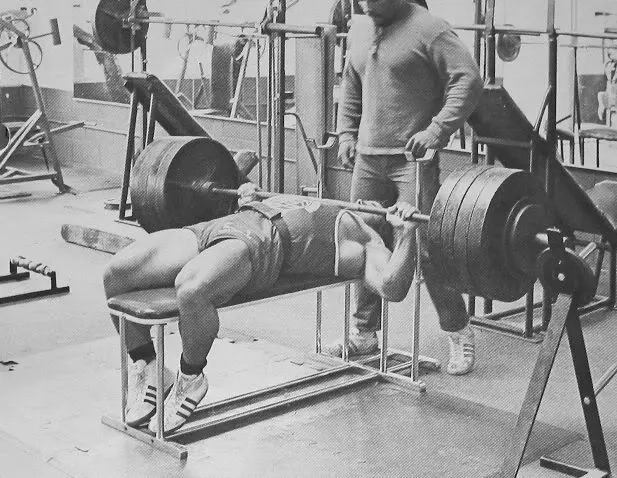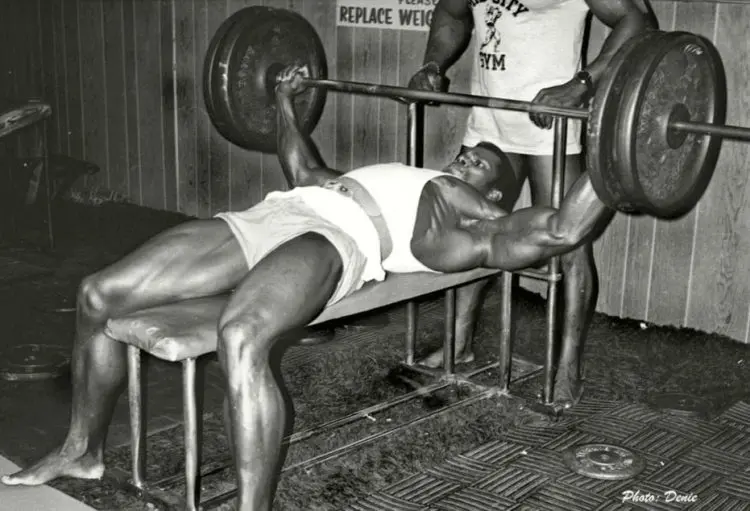When it comes to working out your chest muscles, nothing beats the bench press.
With a bench press, the weight is loaded directly above your chest, and your pecs, shoulders, and triceps work together to lower and raise the weight. It’s an exercise perfect for maximum efficiency and results!
However, picking the right grip width is important for determining the focus of the exercise. Shift your hands in close together, and the exercise focuses more on the center of your chest and your triceps. Slide your hands farther apart, and you get more focus on your chest at large.
A lot of powerlifters will opt for a wide grip bench press because it enables maximum chest muscle recruitment. Simply put: you get more PUSH from your muscles, allowing you to lift more weight and reducing your range of motion.
Below, we’re going to take a deep dive into the Wide Grip Bench Press, looking at the science of why it’s better, the benefits and risks of the wider grip, and the advice that will help you nail the form all day every day!
What is a Wide Grip Bench Press?
There are four basic Bench Press grips:
Level Up Your Fitness: Join our 💪 strong community in Fitness Volt Newsletter. Get daily inspiration, expert-backed workouts, nutrition tips, the latest in strength sports, and the support you need to reach your goals. Subscribe for free!
- Close Grip – Typically, your hands are 10-12 inches apart, near the center of the bar. This places more emphasis on the center of your chest muscles, along with greater shoulder and triceps engagement.
- Regular Grip – With this grip, you typically hold the bar at roughly 1.5x shoulder width, with your elbows flared out to a 45-degree angle. This is the most natural-feeling grip, and the one that most weightlifters (especially beginners) use.
- Reverse Grip – With this grip, you reverse your hand placement, gripping the barbell like you would a Chin-Up bar. This places more emphasis on your forearms, triceps, upper chest, and shoulders.
- Wide Grip – Typically, your hands are 3-5 inches closer to the weight discs than with a regular grip bench press, with your elbows flared out to an 80-degree angle. This widens your grip, placing greater emphasis on your outer pectoralis muscles and shoulders. There is less focus on your triceps and your range of motion is much shorter.
The Science Behind the Movement
There have been a surprising number of studies on the bench press, and how to optimize hand placement and grip to recruit maximum load.
Let’s take a look at a few:
A 2017 study compared regular, narrow, and wide grips with incline, decline, and flat bench placement. The regular and wide grips led to the best electrical muscular activity—i.e. the best muscle recruitment. But, as the study summed up, “we recommend the use of a wide grip on a flat bench during high load hypertrophy training to bench press athletes.”
As for the fluidity of motion, a 2016 study examined the kinematic effects of three different grips (close, regular, and wide) to determine if there was a “sticking point” where the joints worked less efficiently to produce vertical force. There was, indeed, a sticking point discovered, but it was produced at a different arm angle depending on the grip width. This joint angle-specific sticking point is one reason that people often opt for the wide grip, as the reduced range of motion means they can transition through the movement more effectively with maximum force.
A 2021 study took that kinematic analysis a step further, looking at the specific movement created by using the close, regular, and wide grips. This study found that wide and medium grips led to better force generation (participants benched 5-6 kilograms more). Wide grip also led to greater lateral movement, while there was less recruitment of the triceps—ergo, more focus on the pecs and shoulders.
As the study concluded, “when the goal is to lift as much as possible during 1-RM bench press attempts among recreationally trained males, our findings suggest that bench pressing with a wide or medium grip width may be beneficial.”
On the other hand, a 2020 study examined the results of various grips and determined that while regular and wide grip bench presses were the most effective, it was better for each person to self-determine the width that worked best for them.
In another 2020 study, the scientists found that “no significant differences between the grip widths” (wide and regular) were observed in regards to reliability and effectiveness of the bench press.
Back in 2019, a study found that the width of the grip was less important than the tempo of the movement. Moving at a steady rhythm led to the best results, regardless of grip width.
What does all this mean?
- For maximum focus on your chest, shift to a wider grip.
- Shifting to a wider grip doesn’t necessarily mean better bench press form—it’s a small change that can lead to subtle improvements, but not a night-and-day difference from a regular grip bench press.
Related: Try our Bench Press Calculator.
Wide Grip Bench Press Benefits and Risks
Now that we’ve taken a look at the science behind the movement, let’s dive into why you should consider doing wide-grip bench presses, and what the risks are with this exercise
The Benefits of Wide Grip Bench Presses:
Focus on the pectoralis muscles
As the science above made clear, there is less tricep recruitment with the wide grip, so the focus is chiefly on the chest, with a bit of secondary shoulder muscle recruitment. The wider grip hits the outer pectorals (near your armpits) to build that wide, broad-looking chest.
More weight
With the wide grip, you are able to push fractionally more than you’d be able to with regular grip, and significantly more than close grip. If you’re looking to max out your 1RM, it should be your go-to.
Level Up Your Fitness: Join our 💪 strong community in Fitness Volt Newsletter. Get daily inspiration, expert-backed workouts, nutrition tips, the latest in strength sports, and the support you need to reach your goals. Subscribe for free!
Easier on the wrists
The close-grip bench press can put a strain on your forearms and wrists, and many people find that they prefer the wide grip to the medium grip because it feels more comfortable or natural for their wrists. In the end, however, this really comes down to personal preference—whatever feels best for you, that’s what you should do.
Easier on the elbows
With more focus on the chest and less strain on the triceps, you’ll find that there is less risk of exacerbating existing elbow injuries. For people who feel elbow pain during the bench press, shifting the grip wider can help to prevent the strain on their joints.
The Risks of Wide Grip Bench Presses:
Higher risk of shoulder injury
With the wide-grip bench presses, there is a higher risk of shoulder instability (particularly in the anterior deltoids), which can lead to a greater rate of shoulder injury. The amount of torque generated by the shoulders is 1.5x greater with the wide grip bench press, which can increase the risk of injuries. For those concerned about or recovering from shoulder problems, it may be better to stick with the medium grip presses.
Higher risk of pec injury
Because the focus of the movement is mostly on your pectoralis muscles, there is a greater risk of overloading the muscle (with too much weight) and tearing connective tissue. Some coaches believe that the chances of pectoralis major rupture are higher with wide grip bench press.
Where You’ll See the Results of Your Wide Grip Bench Press
With a wide-grip bench press, the visible results (muscle growth) will chiefly be in your mid and lower pectoralis muscles. You won’t see as much growth in your shoulders or triceps, as the shorter range of motion leads to more focus on the pecs.
The good news is that these muscles (mid and lower pecs) are the larger of the chest muscles, and have the largest potential for growth. Using the wide grip can help to build sheer size and raw power in your chest.
How to Perform the Wide Grip Bench Press to Perfection
The exercise is an excellent one, and very easy to follow through from start to finish:
Step 1: Lie on your back on the bench (start with flat), and reach up to take the bar in a “regular” grip. Now, slide your hands 3-5 inches outward, toward the weight discs. Find the placement that feels most natural for you to hold the weight without your arms being fully extended outward. Your elbows should be bent at an 80-degree angle with the wide grip.
Step 2: Push the weight up off the rack, and bring it to the “ready” position directly over your chest. You should aim for the midpoint of your chest, about an inch higher than your nipples. Keep your wrists straight to reduce wrist strain and to keep the exercise focused on your chest, not your forearms.
Step 3: Inhale as you lower the weight to just above your chest. Stop before the barbell makes contact with your chest.
Step 4: Exhale strongly as you push the weight back up. Stop before your elbows extend fully—you do not want the joint to lock!
Step 5: Hold for a half-second at the top of the movement, then inhale and lower again.
Step 6: Repeat as desired.
See how easy that is? It’s a simple movement that anyone can do, which is what makes it such an excellent choice for your resistance training.
How to Maximize Results With a Wide Grip Bench Press
Want to make the most of your wide grip bench presses? Here are some tips to help you maximize results:
Set your goals
If you’re shooting for raw power and improving your 1-Rep Max, lift in the 3 to 5-rep range. If you want muscle size and strength, lift in the 6 to 10-rep range. If you’re after building muscular endurance, work with the 15 to 20-rep range.
Knowing your ultimate goals for working out will help you determine the best ways to structure your training sessions.
Switch it up
As good as the wide grip bench press is for targeting your pecs, it’s not the ONLY exercise in your arsenal. Try mixing things up with variations: regular grip bench presses, dumbbell presses, even close grip presses. You can make wide grip bench presses your main focus, but adding in these other exercises will build better overall chest musculature—leading to better strength, size, and shape.
Train your chest more often
Training the same muscle 2-4 times per week can lead to better muscle growth, as well as better strength increases, as one study found. Start off with two chest workouts per week, then increase as your body grows accustomed to the load on your muscles.
Train your secondary muscles
The focus of the wide grip bench press is on your chest, but your shoulders and triceps are both recruited for the movement as well. Training your shoulders and triceps will lead to better overall pushing strength, enabling you to lift more when it comes time for wide grip bench presses.
Read also:
- Floor Press Vs. Bench Press – Which One Should You Do?
- Best Barbell Bench Press Variations
- Breaking Bench: What You Need to Know About the Bench Press
- Best Bench Press Alternatives For A Big, Powerful Chest
- Dumbbell Bench Press Guide
Conclusion
The wide grip bench press is, without a doubt, one of the best chest-focused exercises you can do. It’s worth reading through this article again to make sure you’ve absolutely nailed the form and learned everything you can about how to do the Wide Grip Bench Press right.
Then, incorporate it into your weekly workouts and see the results. When performed correctly with sufficient weight, you’ll mitigate the potential risks and see big gains in your chest size and strength. It deserves a prominent place in your Chest Day workouts for sure!












